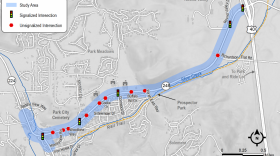The Park City Council voted to approve a joint resolution with the Summit County Council expressing their official stance on the SR 248 project to the Utah Department of Transportation.
Mayor Andy Beerman wants the public to know that Park City came to UDOT asking for help on SR 248 to deal with traffic through bus lanes, improved park and rides and addressing the chokepoint where two lanes narrow down to one. Beerman says most towns would have loved the preferred alternative, which includes four lanes of traffic on 248 from 224 to U.S. 40, plus a center turn lane; turn lanes at intersections; and a widening of the shoulders for potential use by transit. But Beerman says Park City has made clear to UDOT that they’re a different kind of community.
“We've gone through this process—they've heard solidly from the public, they've now heard from our council, and we've begun conversations with them," Beerman said. "Is there an incremental approach to this? Are there small things we can do that facilitate buses in our park and rides that we can start out with, that don't require these big road improvements, which we neither have the funding nor the community desire to do.”
The Summit County Council approved the resolution the day before the city council. The resolution acknowledges what the city and county are already doing to mitigate traffic—pursuing transit and other modes of transportation—and that the city and county want to work cooperatively with UDOT on a project that aligns with residents’ values and addresses transportation needs.
Councilmember Tim Henney suggested the way Park City has worked with UDOT mirrors the way the city has worked with Rocky Mountain Power in transitioning away from coal and toward renewable energy, suggesting UDOT might be more amenable in the future to projects that focus on alternative forms of transportation.
“So, these big state agencies that kind of work on the old paradigm—they do evolve, and sometimes a community like ours and going through an exercise like this helps that evolution," Henney said. "If we can bring them along a little closer to what we're looking for, I think in the long run they're going to look back and say, 'that was a really good thing for us to go through.'”
Beerman can’t say for sure what plans will or won’t move forward on the corridor.
"We're optimistic that UDOT’s going to be a great partner, as they've been in the past, and work with us, and we’ll end up with a result much more along the lines of what we originally intended," Beerman said.
Now that the public comment period is over, UDOT will analyze and respond to the comments to finalize the environmental assessment, before making a final decision on the project this fall.


